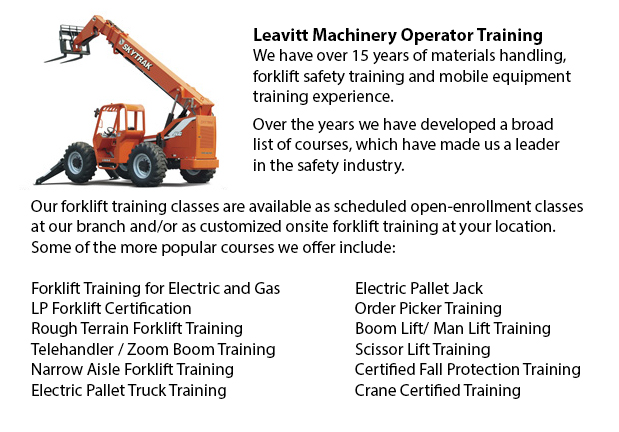
Zoom Boom Training Prince Albert - Zoom Boom Training focuses on correctly training potential operators on variable reach forklifts. The training objectives include gaining the understanding of the machine's physics and to be able to define the job of the operator. This course follows North American safety standards for lift trucks. Zoom boom training and certification is accessible at the company's location or at our site, provided there are a minimum number of trainees. Certification given upon successfully completing it is good for three years.
A telescopic handler (also referred to as a telehandler) is similar in some ways to both a forklift and a crane. It is a useful equipment designed with a telescopic boom which can extend forwards and lift upwards. Different attachments can be connected on the end of the boom, like pallet forks, bucket, lift table or muck grab. It is popular in industry and agriculture settings.
The telehandler is a common utilized along with fork attachments in order to enable the transporting of loads. Telehandlers have the advantage of being able to reach those inaccessible places which cannot be reached by a standard forklift. Telehandlers could remove loads that are palletized from within a trailer and putting them on high places like rooftops. For some applications, they can be much more efficient and practical compared to a crane.
The disadvantage of the telehandler is its instability when lifting heavier loads. As the boom extends with a load, the unit becomes increasingly unsteady. Counterweights in the rear help, but do not solve the problem. The lifting capacity quickly decreases when the working radius increases. Several equipment come along with front outriggers which extend the lifting capacity whilst the machinery is stationary.
To determine whether a load is too heavy, the operator can check with the load chart. The factors covered in the calculation consists of load weight, boom angle and height are calculated. Several telehandlers have sensors which provide a warning or cut off further control if the unit is in danger of destabilizing.
-
Bucket Truck Training Prince Albert
Bucket Truck Training Prince Albert - The Vehicle-Mounted Aerial Work Platform or also called bucket truck training program is intended to reduce the chance of incident and personal injury when working with or in close proximity to bucket trucks by e... More -
Aerial Lift Training Prince Albert
Aerial Lift Training Prince Albert - An aerial work platform is a mechanized access platform. This device provides access to otherwise not accessible places for people or equipment. Likewise called an aerial device or elevating work platform, the mac... More -
Overhead Crane Ticket Prince Albert
Overhead Crane Ticket Prince Albert - The overhead crane is a common heavy machinery utilized in industrial settings. This particular machine is known as a bridge crane and comprises parallel runways spanned by a traveling bridge. The hoist is the co... More -
Scissor Lift Ticket Prince Albert
Scissor Lift Ticket Prince Albert - Scissor lifts have greatly benefited construction operations because the task that used to need a lot of effort and lots of people, can now be accomplished using the scissor lift and just one individual, the operat... More -
Manlift Training Prince Albert
Manlift Training Prince Albert - Different manlift training programs include the review and content of manlift devices. An essential part of the program is the practicum where students demonstrate their knowledge and practical ability to operate the... More -
Skid Steer Loader Training in Prince Albert
The engine powered skid-steer loader consists of a rigid and small frame, equipped along with lift arms which could attach to various industrial attachments and tools to be able to perform various labor saving tasks. Normally, skid-steer loaders are... More -
Crane Training School Prince Albert
Crane Training School Prince Albert - We provide industry relevant programs in our crane training school. The course will provide our trainees with learning outcomes matching the existing industry demands. Our small class sizes combine theory and han... More -
Overhead Crane Operator Training Prince Albert
Overhead Crane Operator Training Prince Albert - Our overhead crane operator training program is meant to teach workers the basics of overhead crane/sling operation and pre-shift inspections. Courses are taught by our professional trainers and consul... More

Forklift Training Prince Albert
TOLL FREE: 1-888-254-6157
Prince Albert, Saskatchewan
forklifttrainingprincealbert.com
Email Us
About Us


